Participating in Course Discussions
About Course Discussions
Course discussions give you the opportunity to start conversations with other learners, ask questions that other learners or members of the course team can answer, and interact with other learners in the course.
Where do I find course discussions?
In your course, select the Discussions tab.
On the left side of the Discussions page, the navigation pane displays all of the topics and posts in the course's discussions. All topics, both course-wide and content-specific, can be read and posted to from the navigation pane.
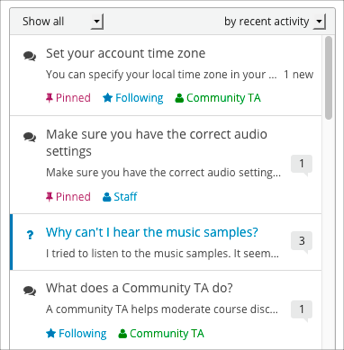
In the main area of the Discussions page, when you have not selected any topics or posts, you see a "How to use UC San Diego Online discussions" graphic. The graphic shows the basic actions you can take with course discussions. Select the receive updates option in the graphic to receive a daily email digest of new activity from your course's discussions.

Learn to search, sort, and filter discussions.
What are discussion topics?
Discussion topics are created by the course team and organize all posts in the course discussion. Discussion topics can be course-wide or content-specific.
- Course-wide topics cover matters that relate to the entire course, such as "Frequently Asked Questions" or "Troubleshooting". In the discussion navigation pane, course-wide topics do not have other topics indented below them.
- Content-specific topics exist "inline" as part of a course unit, and relate to specific pieces of course content, such as videos, reading assignments, homework problems, or other course content. For example, after you watch a video, the course team might add a content-specific discussion so that you and other learners can discuss the video. In the discussion navigation pane, content-specific topics are indented under an identifying category name.
How do I join my course's discussions?
You can ask a question or start a conversation within a topic, or respond to someone else's post or response. Learn to add posts in the discussion forum.
Join Course Discussions
On the Discussions page of your course, you can browse and contribute to course discussions.
A "How to use UC San Diego Online discussions" graphic displays in the main area of the Discussions page when you have not selected any topics or posts. The graphic shows the basic actions you can take with course discussions. Select the "Receive updates" option in the graphic to receive a daily email digest of new activity from your course's discussions.

Navigation Pane
On the left side of the Discussions page, the navigation pane displays all of the topics and posts in the course discussions, including inline (content-specific) discussions that are inside course units.

- Posts that appear in blue type with a blue bar indicate posts that you have not read.
- Posts that appear in gray type without a bar indicate posts that you have read.
- The post type icon indicates whether a post is a question or a discussion. Learn to add posts in the discussion forum.
- The check mark icon indicates a “correct answer”. The check mark icon indicates that one of the responses to the post correctly answers the question asked in the post.
- The response or comment count indicator shows the number of responses and comments for a post. The number of new responses or comments that were added after you previously read a post is displayed next to the indicator.
- A “Pinned” label shows that a post has been pinned by administrators so that it always stays at the top of the topic list regardless of sort order.
- A “Following” label marks posts that you are following.
- A “Staff” or “Community TA” label marks posts that were added by course staff or community teaching assistants (TAs).
Add Posts in the Discussion Forum
When you add a new post in a course discussion, you choose:
- The topic of the post
- The type of post: question or discussion
- Where to post: on the Discussions page or (for content-specific topics only) in the course unit.
Deciding on the topic for your post
Every post in a course discussion must be associated with one of the topics that the course team has created. You choose a topic from the list when you create your post. Before you add a post, look through the list of topics in the course discussions so that you can decide which topic is the most appropriate for your post.
Deciding on the type of your post
Think about whether you want to get concrete information (a question) or start an open-ended conversation (a discussion).
- Question posts raise an issue so that course team members, TAs, or other learners can provide answers. If you are asking a question about the course and need an answer from the course team, be sure to create your post as a question, so that the course team sees that a response is required and responds appropriately.
- Discussion posts start a conversation by sharing thoughts and reflections, and invite community participation.
In the discussion navigation pane, the post type is indicated by an icon, so you can easily find question or discussion posts. A question mark icon identifies question posts, and a conversation bubble icon identifies discussion posts.

For course-wide discussion topics, you can add a post on the Discussion page. For content-specific discussions in a course unit, you can add a post either on the Discussion page or directly in the course unit.
Add a post on the discussion page
You can add a post for course-wide or content-specific discussion topics on the Discussion page.
- On the Discussion page, select Add a Post.
- Determine the type of post you want to make, and select Question or Discussion.
- Determine the most appropriate topic for adding your post to, and select the topic from the Topic Area list.
- In the Title box, enter a short, descriptive title. The title is the part of your post that others see when they are browsing on the Discussion page or scrolling through one of the content-specific topics.
- Enter the text of your post. To format the text or to add links or images, use the formatting options above the text box.
Add a post in a course unit
If you come to a discussion as you work through the units in your course, or if you know where in the course a particular discussion originates, you can add a post for that discussion from the unit in your course.
The following steps apply only to content-specific discussions.
- From within your course, open the unit that includes the discussion topic that you want to add a post to, and then scroll to the discussion.
The title and the first line of each post is shown in the list of posts.
To read an entire post and view its responses and comments, select any part of the post preview. - To contribute a new post to the discussion, select Add a Post and follow the same steps that you use to add a post to the discussion page. You can also add responses or comments in discussions.
Note: If you include an image with your post, include a description so that learners who use screen readers to access the course can understand the image’s content and purpose. The description also displays in place of the image if problems occur with the image file. If the image has no functional purpose, leave the Description field empty and select This image is for decorative purposes only and does not require a description. The maximum size for an uploaded file is 1 MB.
Note: In some courses, you can add posts, responses, and comments anonymously. If this is the case, a Post Anonymously option is available under the field where you enter your text. When you post anonymously, the discussion moderation team can see your username, but other learners cannot.
Add Responses or Comments
To participate in an ongoing course discussion, you can reply to an existing post by adding a response, or expand on a particular response by adding a comment.
The same options for formatting the text and for adding links or images are available for responses and comments as for posts. Learn to add posts in the discussion forum.
Add a response or comment on the discussion page
You can add a response or comment to course-wide or content-specific discussion topics on the Discussion page.
On the Discussion page, find the post that you want to contribute to. To help you decide where to add your thoughts, review the current responses and their comments.
- To add a response to the post, select Add A Response. When you have finished entering your response, select Submit.
- To add a comment to a response, move your cursor inside the Add a comment field below the response. When you have finished entering your comment, select Submit.
Add a response or comment in a course unit
You can add a response or comment to a content-specific discussion topic inside the course.
- In the unit that contains the discussion topic where you want to make your contribution, scroll to the discussion.
- Select the post that you want to contribute to. To help you decide where to add your thoughts, review the current responses and their comments.
- Add a response or comment.
- To add a response to the post, select Add A Response. When your response is complete, select Submit.
- To add a comment to a response, select inside the Add a comment field below the response. When your comment is complete, select Submit.
Edit or Delete Posts, Responses, or Comments as a Learner
Unless you are on the course team, you can only edit or delete your own posts, responses, or comments. You cannot edit or delete contributions from other learners.
To edit or delete a post, response, or comment
- Locate the contribution that you want to edit or delete, either in the body of the course or on the Discussion page.
- In the upper corner of the contribution, select the “More” icon (…). A menu opens.
- Edit or delete the contribution.
- To edit the contribution, select Edit, make the changes that you want in the text editor that opens, and then select Update Response. For posts, you can change the post topic and the post type as well as the text of the post.
- To delete the contribution, select Delete, and then select OK in the confirmation box.
Follow Discussion Posts
Follow posts
To follow posts in your course discussions, open the post, then move your cursor over the gray star icon in the upper right corner. Click "Follow".

The star icon turns blue to indicate you are now following this post. When you view this post in the discussion navigation pane, it also appears with a "Following" indicator. Learn about the various indicators in the navigation pane.
Receive daily email digests
To receive a daily email notifying you about new responses and comments on posts that you are following, select the Discussion tab in your course to go to the Discussions page.
In the "How to use UC San Diego Online discussions" graphic in the main area, click the check box next to "Receive updates". This graphic is shown only when you have not opened any posts to view.

Show only posts you are following
In the discussion navigation pane, you can list only the posts that you are following, regardless of the topic that they apply to. To do this, select Posts I'm Following at the top of the topic list.
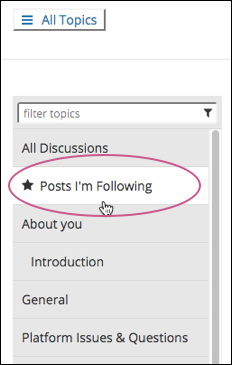
Search, Sort, and Filter Discussions
To more easily find the posts that you are looking for, you can search, sort, or filter posts on the Discussion page.
Search
To search for posts containing a particular keyword or phrase, enter the word or phrase, or a partial word in the Search all posts field at the top of the page.
Search results are displayed in the discussion navigation pane. If an exact match is not found, search results are shown for a similar value.
Search for posts by a specific person
You can also enter a username to search for posts added by a specific person. Select the linked username in the search result to show all discussion contributions made by that person.
Filter
Course discussions are organized by discussion topics, which are created by the course team. By default, All Topics and their posts are shown in the discussion navigation pane.
To reduce the number of posts shown in the discussion navigation pane, you can use one of these filter options.
- Filter by keyword: Enter a keyword in the filter topics field at the top of the topic list to show only topics with posts that have the keyword in their title.
-
Filter by Followed Posts: Click Posts I'm Following at the top of the topic list to show only posts that you have followed.
-
Filter by Unread or Unanswered Posts: Click All Discussions and then select an option from the Show all posts drop-down menu. You can choose to view posts you have not read, or question posts that are unanswered. You can also find your own discussion posts.
Sort
If you do not use any filters or sorting, by default you see All Topics in the discussion navigation pane. To sort the posts, click and then select one of the sorting options.
- Sort "by recent activity": The most recently updated posts appear at the top of the list. Post updates include new responses or comments.
- Sort "by most activity": Posts with the most responses or comments appear at the top of the list.
- Sort "by most votes": Posts that have received the highest number of votes appear at the top of the list. In this view, instead of the response and comments count indicator, the number of votes that each post has received is shown. Votes for responses are not included in the number. Learn how to vote on discussion posts.
Note: Indicators in the discussion navigation pane on the Discussion page provide visual cues to help you distinguish posts that are new, or that have responses or comments that you have not read yet. Indicators also highlight posts from course staff or the community TA. Learn about the labels and icons used in posts.
Find Your Own Discussion Posts
To find posts that you added to course discussions, enter your username in the search field on the Discussions page, then click Search.
In the navigation pane on the left side of the page, posts that you added are listed under the heading "Show posts by (username)". Click each post to open the full discussion thread in the main area.
To view all your discussion activity, including responses and comments, click the linked username in "Show posts by..." to open a discussion page that shows all of your discussion activity for the course.
Vote on Discussion Posts
To provide positive feedback for a post or one of its responses, you can vote for it. Open the post or response, and click the plus sign (+) icon next to the number of Votes.
To remove your vote from a post, click the plus sign icon again.
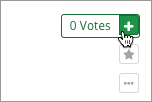
You can only vote for posts added by other discussion participants. You cannot vote for your own posts.
In the discussion navigation pane, you can sort the list of posts so that the posts with the most votes appear at the top. To do this, click All Topics or All Discussions. Click the arrow next to the sorting drop-down option that appears, and select by most votes.Enter Math Expressions in Course Discussions
Entering math expressions in course discussions is different from entering math expressions in a math problem or in the calculator. In course discussions, you use MathJax to format the text that you type.
MathJax automatically formats the mathematical symbols and equations that you enter in HTML. Many resources for learning and using MathJax are available online, including the official MathJax Documentation . A tutorial is available on the Mathematics meta stack exchange. Additional documentation, with a testing tool, is available on the Tree of Math site. This article provides some pointers to get you started.
A MathJax equation can appear with other text in the paragraph (inline format) or on its own dedicated line (display format).
To write an inline equation in a discussion post, you can surround your MathJax expression with [mathjaxinline] tags. Note that these tags use brackets ([ ]).
[mathjaxinline] equation [/mathjaxinline]
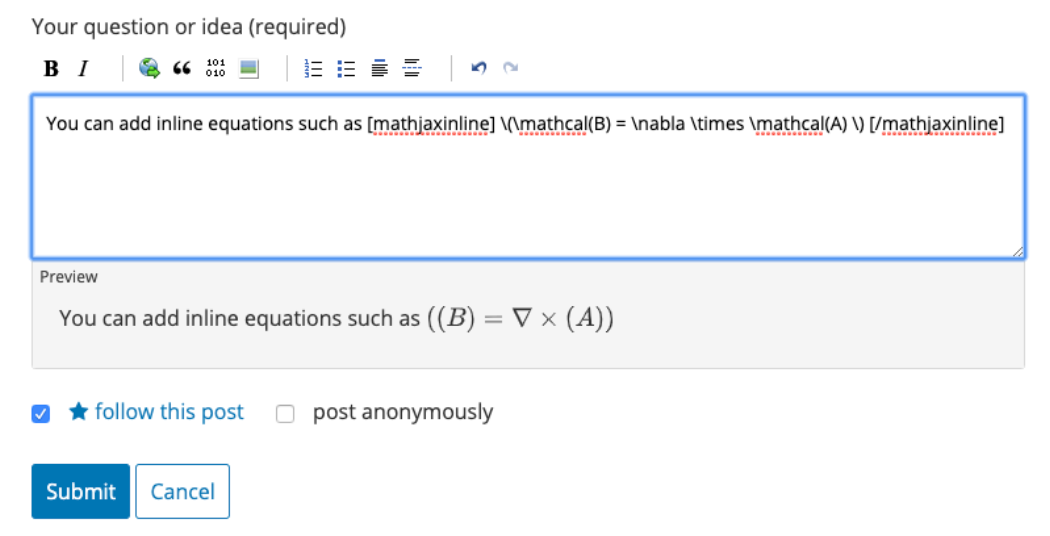
For display equations, you can surround your MathJax expression with [mathjax] tags. Note that these tags also use brackets([ ])
[mathjax] equation [/mathjax]
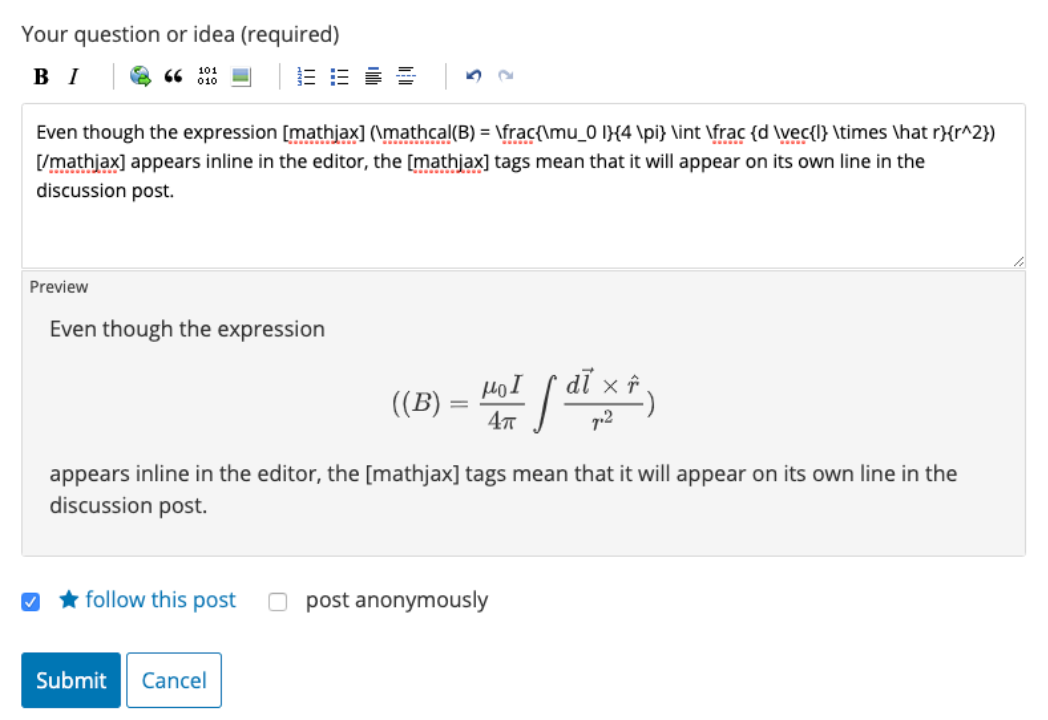
Answer Questions in Discussion Posts as a Learner
Anyone in a course can answer questions that are posted in the course discussions. To respond to a question that has been asked by someone else in the course, add a response with your answer to the question post.
If you have received a helpful or correct response to a question that you yourself have asked, you can also mark the response as the correct answer. To do this, move your cursor over the check mark icon for the response, and then select Mark as Answer.
Note: The discussion moderation team can mark any response as correct. Learners can only mark responses as correct for their own posts.
After at least one response to a question post is marked as a correct answer, a check mark icon replaces the post’s question mark indicator in the discussion navigation pane.
Receive Discussion Notifications
In addition to using the indicators in the discussion navigation pane to find out if there are new or unread posts and responses in discussions, you can also receive email notifications.
If you have added a post to a discussion, the first time another learner or a member of the course team adds a response to your post, you receive an email notification. If you do not want to receive this email notification, clear the Receive updates checkbox before you add your post.
Receiving Daily Digests
You can subscribe to a daily email message that summarizes discussion activity for the posts you are following. To subscribe to the daily digest, follow these steps.
- In your course, select Discussion.
- In the How to use UC San Diego Online discussions graphic, select the Receive updates checkbox.
Unsubscribing from Notifications
If you want to unsubscribe from notifications, complete either of these actions:
- If you received an email message, select Unsubscribe in the message.
- On the Discussion page in your course, clear the Receive updates checkbox in the How to use UC San Diego Online discussions graphic.
Note: These actions unsubscribe you from daily digest email messages. If you create a new post, you will still receive an email message the first time that a learner responds to that post. To prevent an email notification for a post, clear the Receive updates checkbox before you add the post.
How To Report Inappropriate Discussion Posts as a Learner
On rare occasions you might come across a discussion contribution that is inappropriate. You can flag any post, response, or comment for a discussion moderator to review. To do so, open the contribution, select More, and then select Report.
The discussion moderation team can investigate any flagged posts, responses, or comments and take the appropriate action.
Note: Only the person who flagged a contribution and the discussion moderation team can see that a contribution has been reported.